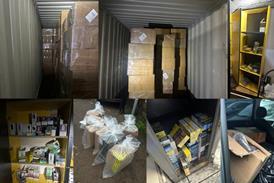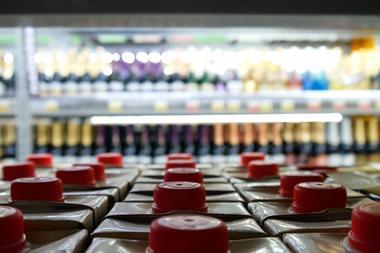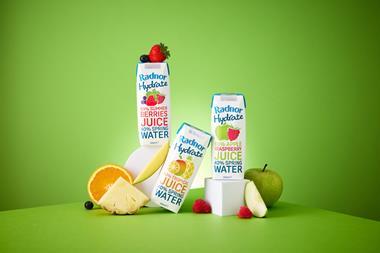Imagine a thirsty shopper beamed Back to the Future-style from 1980s England to a present day c-store. Chances are they’d still recognise the reds, whites and blues of the soft drinks category, but as they grabbed a can they’d also see that a sector once all about sugary drinks now chimes with modern times.
75%
That’s the percentage of consumers who purchase carbonated drinks, according to Mintel
“Consumers tell us that they’re looking for healthy options,” says Georgina McElwaine from GlaxoSmithKline, the company behind the Lucozade brand.
“Health can mean different things to different people. It can be anything from a lower-calorie alternative, to an everyday drink, through to offering an additional functional benefit.”
For Coca-Cola, one of the category’s truly iconic products, this new onus on health has meant engaging with the obesity debate like never before. For instance, the brand’s recent ‘Be OK’ TV ads focused on the feel-good activities Coke-drinkers could do to help burn off the calories in one can.
“It’s an exciting time to be engaged in this debate and I think that we’ve really put our head above the parapet on this one,” says Coca-Cola Enterprises (CCE) customer development director Darren Goldney. “There’s an obesity problem in this country and by all stakeholders coming together I think we can find a solution.”
Goldney points out that a large percentage of the drinks sold by CCE are low calorie or zero calorie - and that he believes it’s all about providing consumers with the right information, and a wide choice of soft drinks.
“The soft drinks category is really big so you can afford to give customers a choice, which you can’t in the same way in something such as crisps or confectionery,” he says.
Perhaps more controversial than obesity for retailers has been the issue of Coke’s changing pack sizes. This year CCE announced a move to replace 2ltr bottles of key brands with 1.75ltr sizes at a reduced price.
“There’s been some debate, and we think it’s a tremendous opportunity,” acknowledges Goldney.
In the fast lane
If your store is in an area where people like to keep on the go, then the sports drinks sector can be a canny chiller investment. Brands such as Lucozade have mashed up the trends for health and functionality with new products that aim to inspire health-conscious consumers to new heights of performance.
“Innovation and NPD was fundamental to driving market performance in 2012, with marked success from products which directly aligned to the consumer demand for healthier/low-calorie alternatives,” says Georgina McElwaine from GlaxoSmithKline. “Building on this knowledge, the makers of Lucozade launched Lucozade Revive - specifically designed to meet demands for a light, energising drink with reduced calorie content.”
Away from the gym, consumers have been keying into the fact that high-protein products can help keep them performing throughout the day. It’s a trend The Good Whey Company is tapping into with its new Upbeat dairy drink, which is supported by a £2m ad campaign.
Elsewhere in the chiller, it’s important to remember juices and smoothies as the ultimate on-the-go healthy fruit hit.
“Smoothies add incremental sales to soft drinks and juices as they deliver against different needs, states and occasions throughout the day, with smoothie consumption tending to take place in the afternoon,” says Patrick Kalotis, group marketing director at Pepsico.
“Naked Juice presents a huge opportunity for retailers and is driving the growth in smoothies, representing 77% incremental sales.”
He explains that though the bigger packs are doing well in the supermarkets, an “everyday affordable price point” is more important for c-store customers.
“We understand that retailers are concerned about not being able to sell the same amount of liquid,” he says. “If we didn’t believe the new packs could sell more bottles we wouldn’t do it - because we want to sell more products as well as the retailers!
“Whenever you make a change you get concerns - and our message to retailers is to get behind it and help make it work.”
It’ll be interesting how the debate shapes up, especially since Pepsi is keen to trumpet its pack sizes in convenience.
“We’ve played hard at ‘bigger is better’ with pack sizes in impulse brands such as Pepsi, now with a ‘20% more’ label on-pack,” says Nigel Paine from Britvic.
He maintains, like Goldney, that retailers and manufacturers have to understand the importance of pack price. “We’ve seen that consumers have been moving away from multibuys into single price promotions,” he says.
“Britvic has moved in 12 months from having little involvement in pricemarked packs (PMPs) to a more industry normal level. The PMPs are across formats rather than brands, and include Tango, 7 Up and Mountain Dew.”
As well as promotions, keeping brands in the forefront of consumers’ minds also plays a part in their success. To this end, AG Barr is embarking on a six-month programme of support for Irn-Bru, the UK’s number one flavoured carbonate (Nielsen Scantrack, MAT to February, Total Impulse).
The £5m ‘Irn-Bru Gets You Through’ campaign will feature special packs, dedicated POS, a new website and social media support, as well as the TV campaign which runs until the end of June.
The three tongue-in-cheek ads look at how a sip of the soft drink can help get you through difficult situations.
All fired up
The increasingly common sight of bleary-eyed teens emerging from c-stores with cans of energy-providing products is proof positive that the sector still provides a shot in the arm for soft drink sales.
“In the past year the energy drinks market has experienced significant growth, with the market now worth £521m and showing annual growth of nearly 12% - much faster than any other category within the soft drinks market,” says No Fear brand manager Neal Haworth.
“When energy drinks were first launched they were targeted towards athletes, but they have now moved to focus on teenagers and young adults because of their on-the-go lifestyle, which shows no sign of slowing down.”
Retailer’s view
“At the moment, our Coke 500ml ‘two for £2’ promotion is going really well, as is the Pepsi BOGOF deal. Basically, anything with a promotion is selling!”
“We’re also seeing Monster do really well in energy, plus Lucozade Pink Lemonade is doing lots of business. With those products it tends to be mainly teenagers coming in and buying them. But if you look at the wider category, though, soft drinks goes right across the board. We’ve got loads of construction going on in the area, so those workers come in and buy Coke, Red Bull and Lucozade.”
“In terms of the best-seller, it’s still Coke. Big advertising campaigns help sell the products, but it’s promotions that sell the category through.
“To get the category right retailers should look at their industry planogram, then tweak it so it meets local needs.”
Roli Ranger, Londis Ascot, Berkshire
Today the trend in energy drinks is all about the price - with virtually every brand now available in PMP format - and taste. According to Mintel a growing number of young consumers are just as likely to choose an energy drink as a change from the usual carbonates as for its functional properties - which means that manufacturers have been busy cooking up new formulations such as Relentless apple & kiwi and lemon ice.
While new flavours bring more mainstream consumers into the market, there’s also room for super-powered products aimed at the category’s thrill-hungry core fan base. No Fear’s new Supercharged variant boasts an eye-opening 50% more caffeine than its parent brand.
But as we’ve seen, sugary drinks and young people make controversial bedfellows. So might there be a similar issue with caffeine content?
Says Goldney: “Caffeine is not a new query. In terms of context, regular energy drinks have about the same amount of caffeine as a Starbucks or Costa, and there’s not the same kind of debate about young people drinking coffee. The key thing we can do is make sure labelling is appropriate.”
Adds Haworth: “Energy drinks work the same way as most things in that it is all down to people being sensible and enjoying them in moderation.”
With galloping growth, and a young demographic, it looks like the energy drinks sector has the future of soft drinks all sewn up. Yet there’s still room to grow the market further.
Goldney believes that there’s lots of room for low- and no-sugar variants - plus ways to draw women in, through smaller format cans. And as Adrian Troy from AG Barr - who has seen double-digit growth with its Rockstar brand - points out, teens drinking energy drinks now will probably take the habit into adulthood.
“I think of energy drinks as ‘young person’s coffee’,” he says. “As the consumers get older they’ll take their soft drink habits with them and we’ll continue to see growth in the market.”
Ones to watch
Back in fashion
Are you old enough to remember Vanilla Coke? The flavoured fizz is back due to popular demand and the focus for an ageing Facebook generation eager to re-experience and share the taste of childhood. Pricemarked 500ml bottles are available.
rrp: 59p cans, ‘two for £2’ 500ml bottles
tel: 08457 227 222
Feel the rush
With 50% more caffeine than its parent brand, No Fear Supercharged gives buzz-hungry energy drink fans another reason to get on their skateboard and shop. Plus, the smaller 355ml can size and resealable opening means they can stash it under their hoodies to save some for later.
rrp: £1.19
tel: 01942 408600
Pole position
Lucozade is painting some go-faster stripes on the side of the sports drink category with the launch of a Jenson Button-endorsed Champion’s range. It’s available in two on-trend exotic flavours (mango & passionfruit and lemon & lime), designed to send sales soaring off the grid.
rrp: £1.39
tel: 08702 415132
Bru up
The secret is out - some 40% of sales featuring Scots’ favourite fizzy pop/hangover soother now take place outside Scotland. And the launch of this year’s typically quirky ‘Irn Bru gets you through’ ad campaign should see a few more, if only among ex-pats looking for a taste of home.
rrp: 76p
tel: 01204 664295
Sweet ‘n low
Soft drinks manufacturers puzzling over how to make drinks healthier without impairing taste could have found a saviour in stevia. CCE is showing its support for the natural sweetener by introducing it to Sprite in a bid to cut calories by some 30% without negatively impacting the flavour of the drink.
tel: 08457 227 222
Source
Matt Chittock































